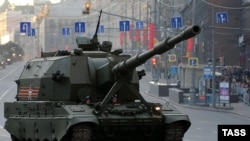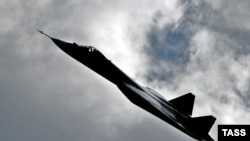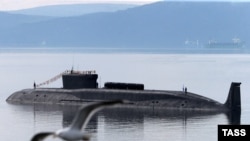Military modernization has been a priority of Vladimir Putin's Russia for more than a decade. Military spending has increased every year since Putin came to power in 1999.
For 2015, according to the State Duma's Defense Committee, spending will reach $81 billion, or 4.2 percent of Russia's gross domestic product, and account for about 20 percent of government spending.
More than half of defense spending in Russia is devoted to the state armament program, according to Deputy Defense Minister Tatyana Shevtsova. The volume of state defense orders will rise by 40 percent in 2017 compared to 2014, the government has said.
The fruits of that spending are now rolling off the assembly line. The country's new Armata battle tank and a series of other vehicles based on the same chassis participated in the May 9 Victory Day parade in Moscow.
Here are thumbnail sketches of the Armata and some of the other military systems that are expected to come into service in Russia over the next 10 years.
Armata battle tank: A highlight of Moscow's 2015 Victory Day parade will be the public debut of the Armata T-14 battle tank. The T-14 is expected to enter service in 2016 and the military hopes to have 2,300 of them by 2020, according to the state-run Sputnik news agency.
Run by a three-person crew, it features an unmanned turret that is digitally controlled by a crewmember riding in the lower section. Its armor is reportedly specially designed to maintain its specifications in extremely cold temperatures, possibly because Moscow plans to deploy them in the Arctic. It also features highly advanced, fifth-generation radar.
Russian military designers have said the T-14 is a significant advance toward a fully unmanned tank.
Russian media reported that one Armata tank stalled out during the May 7 parade rehearsal and had to be towed away by another Armata-based vehicle.
Other Armata vehicles: The T-14's Armata chassis is intended to serve as the platform for a number of other tracked vehicles, including the Kurganets-25 heavy infantry fighting vehicle, an armored personnel carrier, and the 2S35 Koalitsiya-SV self-propelled howitzer.
According to Jane's 360, the Armata family of vehicles "are principally clean-slate designs and represent the biggest change in Russia's armored fighting vehicle families since the 1960s and 1970s."
The Koalitsiya is a 152-mm self-propelled gun with a high level of automation. It is believed to take a crew of two or three (video of the Koalitsiya practicing for the Victory Day parade).
There have been reports of a double-barreled version capable of striking two different targets simultaneously with precision-guided ammunition. According to some media reports, the double-barreled version has been cancelled.
In March, a video appeared purporting to show a prototype T-15 BMP armored infantry fighting vehicle using the Armata platform at the Nizhny Tagil factory where they are produced. The T-15 also made an appearance at the Victory Day parade in Moscow.
PAK FA T-50 fifth-generation fighter jet: The Sukhoi T-50 is designed to rival the U.S. F-22 Raptor. It was unveiled at the MAKS Air Show in 2011 and is expected to go into serial production as early as this year. Deputy Defense Minister Yury Borisov said the military expects them to enter service in 2016. However, he said in March that the initial order had been reduced from 52 to 12 "given the new economic conditions." (Video of the T-50 in 2013)
The T-50 is a stealth aircraft that was developed jointly by Russia and India. It reportedly includes all the F-22's fifth-generation features -- stealth, supersonic cruising, thrust vectoring, integrated avionics, and active and passive sensors. They cost an estimated $50 million each. It has a supersonic range of 1,500 kilometers and a service ceiling of 20,000 meters.
PAK DA stealth strategic bomber: The PAK DA is currently under development by the Tupolev Design Bureau andis intended to replace both the Tupolev Tu-95 turboprop strategic bomber and the Tu-160 supersonic bomber.
The specifications of the project are unclear. Air Force General Anatoly Zhikharev told RIA-Novosti in late 2012 that the PAK DA will not be capable of hypersonic (above mach 5) speeds. It may, however, be capable of launching hypersonic air-launched nuclear missiles.
The PAK DA was made a military priority in 2014 with serial production set for 2020. In the meantime, Russia announced last month that it is renewing production of the Tu-160, currently the world's largest supersonic bomber. It was not announced how many new Tu-160s will be built.
Sarmat MIRV ICBM: Russia has devoted considerable resources to renewing its strategic nuclear forces -- including land-, sea-, and air-launched weapons. The centerpiece of this renewal is expected to be the Sarmat (sometimes called the Sarmatian), which will replace the SS-18.
The Sarmat is capable of carrying 10 heavy or 15 lighter independently targeted nuclear warheads. It can also carry fewer warheads and a complex array of systems designed to defeat antimissile defenses. The liquid-fueled, silo-based Sarmat will have a range of 10,000 kilometers.
The Defense Ministry announced in June it is "fast-tracking" Sarmat development. Deputy Defense Minister Yury Borisov was quoted as saying Russia's entire strategic nuclear deterrent will consist of modern missiles capable of penetrating "almost any air-defense system" and of traversing the North and South poles.
Russia has also been developing the solid-fueled Bulava RSM-56 submarine-launched ballistic missile. After a series of embarrassing test failures, the Bulava was finally declared operational in October. The Bulava carries up to 10 warheads and has an operational range of 10,000 kilometers.
Borei class nuclear submarine: The Bulava missile is designed for use with the Borei class strategic nuclear submarine. Borei submarines were first conceived in the mid-1980s, but serious work only began in 1996. The project ran up against Russia's financial collapse and was long delayed. The first vessel, the Yury Dolgoruky, was ceremonially launched in 2007 but wasn't accepted into service until 2013. Two more Boreis are nearing completion and Russia plans to build a total of 10. Work has reportedly begun on a fourth Borei, which may be significantly modified and could be considered a Borei-II type.
The subs will enable Russia to regularly patrol the far southern hemisphere for the first time in two decades. Boreis run a crew of 107 and are armed with 16 Bulava strategic nuclear missiles (up to 10 warheads each), as well as torpedoes and RPK-2 Viyuga nuclear-capable cruise missiles.
Perhaps keeping in mind the tragic 2008 sinking of the Kursk, Russia's RT television reported all Borei class subs will have a rescue chamber "designed to fit in the whole crew."
Barguzin strategic ballistic-missile train: Back in the day, the Soviet Union had a rail-based launching system for intercontinental ballistic missiles (ICBMs). At the program's peak, 12 such trains were cruising the Soviet countryside, but they were banned under the START II agreement and were gradually decommissioned between 1993 and 2005.
Russia, however, withdrew from START II in 2002 after the United States withdrew from the 1972 Antiballistic Missile Treaty (ABM). In late 2014, Moscow announced it is developing a new rail-based launch system called Barguzin, each of which will be capable of deploying six RS-24 Yars ICBMs. Each RS-24 has at least four independently targeted warheads.
Yars missiles are also deployed on truck-based mobile platforms and some were shown during the Victory Day parade in Moscow.
Moscow plans to deploy five of the Barguzin trains beginning in 2019.
One of the old Soviet missile trains is currently on display at the Central Railway Museum in St. Petersburg.
S-500 ABM system: Russia has been working on the advanced S-500 antiaircraft and antiballistic missile system since 2002. It is sometimes referred to as Prometei (Prometheus) or Triumfator-M. It is expected to begin testing this year and could be deployed as early as 2017 or 2018.
The S-500 is not an upgrade of the S-400, but a whole new design specifically created to destroy ICBMs. It might also be capable of shooting down low-orbiting satellites.
It is a mobile, truck-mounted system and is expected to be deployed to protect Moscow. It is designed to destroy incoming warheads before they reenter the atmosphere, with the ability to track and destroy about five to 10 targets simultaneously. Some military-watchers have reported Russia is already working on a modified version of the S-500 called the S-1000.
Lada class diesel submarine: Since 1997, Russia has been working on a fourth-generation Lada class diesel-electric submarine (a modified export version is called the Amur class). It is intended for antiship and antisubmarine warfare.
The first Lada attack submarine, the Petersburg, joined the navy in 2010, but has encountered problems and is used only in a test capacity.
Construction on the next three Ladas was suspended from 2011-13 pending design changes. Work has resumed on the second Lada, the Kronstadt, which is being built according to the new design and is expected to be completed in 2017.
In all, Moscow plans to commission eight of them.
Lada subs are significantly quieter than their Kilo-class predecessors and sport new combat systems, including advanced torpedoes and tube-launch cruise missiles. It has an air-independent propulsion system that enables it to remain submerged for up to 45 days with a submerged cruising range of 900 kilometers.
Beriev A-100 AWACS system: In late 2014, Russia announced the beginning of production of the Beriev A-100 Airborne Warning and Control System (AWACS), to be based on an upgraded Ilyushin Il-76MD. The A-100 will replace the current A-50s that were deployed between 1978 and 1992.
Development has been under way since 2004. According to some reports, 13 are currently in production.
The A-100 will have more advanced radar and tracking systems. According to Jane's 360, the A-100's radar "will provide a dramatic improvement in the platform's ability to detect and track both airborne and land-based targets."
At the same time, Moscow is upgrading its fleet of A-50s, with several upgraded planes introduced to service in 2014.
Skat Stealth Drone: Russia has been developing the Skat unmanned combat drone since around 2007. Both the MiG and Sukhoi design bureaus seem to be working on versions of the Skat (2014 video purporting to show a Skat prototype).
The Skat is designed to carry 2 tons of munitions and has a combat radius of 2,000 kilometers. It has a "flying wing" design and stealth technology.














